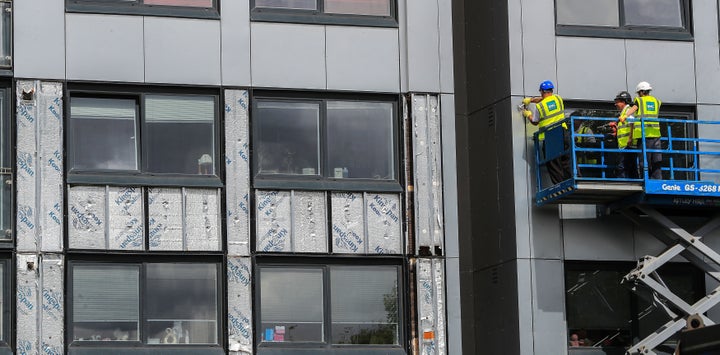More people could be living in “potential death traps” than previously thought after it was revealed a second type of cladding should be removed from towerblocks two years after the Grenfell disaster.
The Ministry of Housing, Communities and Local Government on Thursday slipped out details of how some types of high pressure laminate (HPL) cladding should be stripped from buildings.
Until now, only the type of material that covered Grenfell Tower has been deemed dangerous enough to remove. Ministers recently committed £200 million to the remediation of private sector residential buildings with this aluminium composite material (ACM) cladding.
On Thursday night, Labour accused the government of “a poor attempt at a cover-up” after the new details were not included in a ministerial statement.
It is not known how many buildings have HPL cladding, but a report in The Times has suggested up to 1,700 buildings across the country are covered in combustible non-ACM materials. That would affect almost 200,000 people.
The ministry responded by saying that “no buildings” in the country should have the suspect combinations since they would have failed building regulations. But Labour is demanding the government publishes a full breakdown of blocks boasting HPL as the details have not been made public.
The government’s own report says HPL is popular as it is available in a “wide range of colours and finishes which makes them attractive as a way of bringing colour and different finishes to an external facade”.
In updated guidance published by the ministry, an expert panel concluded that “systems using any type of HPL panels” which are combined with combustible insulation are “very unlikely to adequately resist the spread of fire”.
Building owners who identify these materials on residential buildings over 18m (60ft) in height should take “immediate measures to remediate their system”.
However, one form of HPL cladding that was deemed to meet fire-safety standards was class B (FR) – or fire retardant – a material treated to resist fire spread if it was “properly installed”.

In a written statement, Housing Secretary James Brokenshire highlighted the HPL cladding class which passed the test, rather than the ones which did not.
Brokenshire confirmed “that this system met the relevant pass criteria and that the expert panel is satisfied that this specific system does not present a risk to public safety”, but did not highlight the other types of cladding that were recommended for removal.
In response, Labour’s shadow housing minister Sarah Jones said: “Today’s statement is a poor attempt at a cover-up, highlighting the one combination of cladding and insulation which passed a fire test.
“Worst of all, ministers were made aware of a failed fire test featuring HPL nine months ago and failed to act.”
She added: “The fact that ministers waited until two years after Grenfell to confirm to people that they have been living in potential death traps is a disgrace.”
Lord Porter, the Local Government Association’s building safety spokesman, said delays to the announcement leaves residents facing “another summer of uncertainty over the safety of their homes”.
He said: “Although it is two years since we raised the need to look at HPL with government, five years since an HPL system combined with combustible insulation failed a fire test and 10 years since HPL panels helped spread the fire at Lakanal House where six people died, advice has only just been issued on the level of risk posed by HPL cladding.
“Government needs to give immediate consideration to funding the removal of HPL cladding systems from high-rise residential buildings.”
An MHCLG spokesperson said: “There should be no buildings in this country with this combination of cladding and insulation. Building owners are legally responsible for ensuring the safety of their buildings and need to make sure this is the case.
“They should be well aware of their responsibilities as we issued clear-cut advice in December 2017, reinforced last December, telling them to check that only safe cladding and insulation combinations had been used on their buildings.”

